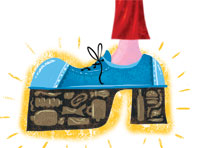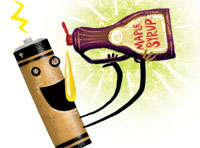Thinking Outside the Recycling Box
Wait! Don’t just throw that bottle in the recycling bin. You could use it to build your own private island. Across the globe, people are coming up with remarkable — and sometimes zany — new ways to help our environment. Here are some of our favorites.
Eco-Island Living
 Take 250,000 or so used plastic bottles; add plywood, bamboo and sand; and — presto — you have a two-story house on your own deserted island.
Take 250,000 or so used plastic bottles; add plywood, bamboo and sand; and — presto — you have a two-story house on your own deserted island.
In 1998, Richart Sowa began building his own tropical paradise on a floating artificial island off the coast of Mexico. He filled nets with the bottles to keep the island afloat and added mangroves and other plants to keep the island cool. He cooked on a solar-powered stove and collected rainwater for bathing.
Unfortunately, “Spiral Island” was washed ashore during Hurricane Emily in 2005. That hasn’t stopped Sowa from getting to work on a second island near Isla Mujeres, Mexico.
Going to the Birds
 Do something innovative with an old computer. In Australia, farmer Rex Harris takes the shells of vintage Macintosh computers, props them on large poles and uses them as birdhouses. He says the ventilation on the front and back of the computers makes them ideal for nesting boxes.
Do something innovative with an old computer. In Australia, farmer Rex Harris takes the shells of vintage Macintosh computers, props them on large poles and uses them as birdhouses. He says the ventilation on the front and back of the computers makes them ideal for nesting boxes.
Harris prefers the original 1984 all-in-one Macintosh, which he finds at flea markets and garage sales. So far, the birdhouses have attracted kestrels, butcherbirds and the colorful Eastern Rosella parrot.
The Power of Poop
 At the Bronx Zoo in New York City, the motto is “your waste will not be wasted.” Normal toilets flush waste into a sewer system. But at the zoo’s eco-restrooms, waste enters a large composting tank below the bathroom. Here, red worms, fungi and bacteria transform today’s waste into tomorrow’s fertilizer. The soil is then used to grow flowers at the zoo’s gardens, which are watered with excess water from the restroom sinks. The composting toilet system saves up to a million gallons of water a year that would typically be used to flush the toilets.
At the Bronx Zoo in New York City, the motto is “your waste will not be wasted.” Normal toilets flush waste into a sewer system. But at the zoo’s eco-restrooms, waste enters a large composting tank below the bathroom. Here, red worms, fungi and bacteria transform today’s waste into tomorrow’s fertilizer. The soil is then used to grow flowers at the zoo’s gardens, which are watered with excess water from the restroom sinks. The composting toilet system saves up to a million gallons of water a year that would typically be used to flush the toilets.
Up on the Rooftop
When Chicago’s mayor decided to put a 20,000-square-foot green roof on City Hall, many citizens thought he was loony. Now they’re green with envy as the new roof absorbs rainwater, cools the building and has saved some $25,000 in energy costs.
Mayor Richard Daley was so smitten with this eco-design that the city has completed or is now constructing more than 4 million square feet of rooftop gardens, more than all other American cities combined. Even a McDonald’s, a Wal-Mart and an Apple store have planted gardens atop their buildings. Would you like some grass stains with those fries?
Green Feet
 When you hear the words “recycled shoes,” you probably think of those worn-out hand-me-downs from your older brother. But thanks to a new company called Worn Again, you can buy recycled shoes that are both eco-friendly and cool.
When you hear the words “recycled shoes,” you probably think of those worn-out hand-me-downs from your older brother. But thanks to a new company called Worn Again, you can buy recycled shoes that are both eco-friendly and cool.
All Worn Again shoes are 80 percent recycled, from materials like scraps of old military jackets, T-shirts, coffee bags and jeans. Our favorites are the Escape and the Bicycle shoe, made from recycled bike tires and rewoven leather and textile fibers.
Worn Agains aren’t cheap at $130, but buying a pair is a good way of telling the shoe industry you care about the environment.
— Mark Anders
Save the Midwest’s Rain Forest
 A rain forest in Iowa? Scheduled to open in 2010, Earthpark will be set inside a giant terrarium along the shore of Lake Red Rock, Iowa’s largest lake. When completed, the four-acre terrarium will stand more than 150 feet high and be home to more than 1,000 species of plants and animals, includ-ing rubber trees, blue macaws, screaming piha birds and freshwater stingrays. Its power will come from solar, wind and geothermal energy sources.
A rain forest in Iowa? Scheduled to open in 2010, Earthpark will be set inside a giant terrarium along the shore of Lake Red Rock, Iowa’s largest lake. When completed, the four-acre terrarium will stand more than 150 feet high and be home to more than 1,000 species of plants and animals, includ-ing rubber trees, blue macaws, screaming piha birds and freshwater stingrays. Its power will come from solar, wind and geothermal energy sources.
— Joseph Baneth Allen
Sweet!
 Anyone who has munched a handful of M&M’s to get up that last bit of mountain trail knows that sugar can give an extra burst of energy. Now researchers at Saint Louis University say the sugar found in maple tree sap or flat soda pop can fuel the next generation of batteries.
Anyone who has munched a handful of M&M’s to get up that last bit of mountain trail knows that sugar can give an extra burst of energy. Now researchers at Saint Louis University say the sugar found in maple tree sap or flat soda pop can fuel the next generation of batteries.
Not only are they three to four times longer-lasting than the typical lithium ion battery (used in cell phones, laptop computers and iPods), these sweet new creations are also biodegradable. Look for them to hit the market in the next five years.
From Mean to Green
Across America, big abandoned city areas that were once eyesores are being turned into fun urban parks. In 2005, the Seattle Art Museum began transforming a vacant industrial site into the Olympic Sculpture Park which opened last year.
In Boston Harbor, Spectacle Island was just a garbage dump. Environmentalists suggested taking the dirt excavated from “The Big Dig,” a big traffic tunnel under the city, to reshape the island and provide topsoil for plants and trees. The 100-acre park now has a trail system and beach.
Soon to open in New York City is High Line urban park, formerly an elevated train track that was in disrepair for the past 20 years.
yeah
theese things are really cool
I use shoe boxs to hold things like these cool ideas.
These environmentally friendly concepts are so cool! Now if only we could apply them to EVERYONE in everyday life.